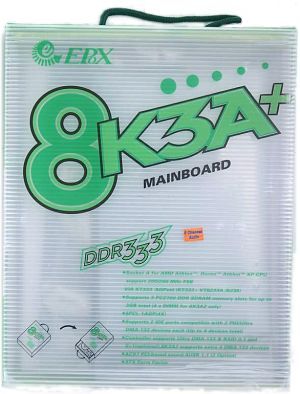EPoX 8K3A+ (VIA KT333) Mainboard
|

The PCB of this model was also redesigned in comparison to the KT266A
board because of the integrated IDE RAID controller.
Accessories:
- Package: a box with a handle of the standard design;
- Documentation: a user manual and an installation manual for IDE RAID -
both in English;
- Cables: 1 ATA66/100, 1 ATA33 and 1 FDD;
- Bracket with two USB ports and a game port;
- Diskette with drivers for IDE RAID;
- 2 CDs with software including:
- drivers;
- Drive Image 4.0;
- Partition Magic 6.0 SE;
- Norton Ghost 6.03;
- PC-Cillin 2000;
- several system monitoring utilities;
- Boostek;
- Adobe Acrobat Reader;
- DirectX 7.0a.

The layout is rather good, except audio-ins which are located in front
of PCI slots, IDE connectors are behind them, a power connector is between
the socket and the AGP slot, and if the board is installed it's difficult
to reach the DIMMs. Besides, it is not a good solution to place a part
of the element base of the processor stabilizer on the back side of the
board. Free space around the AGP Pro connector makes possible to install
GeForce4 video cards without problems. It's not difficult to reach jumpers
even when the board is already installed. Functions of almost all jumpers
and switches are shown on the textolite.

The 3-channel switching voltage regulator incorporates 12 capacitors
of 2200 uf.
The following controllers are integrated: an audio one based on the
chipset's capabilities and the AC'97 codec Avance Logic ALC650, it has
a SPDIF connector for 6-channel audio systems; an IDE RAID controller on
the HighPoint HPT372 which can create RAID arrays of 0, 1 and 0+1 levels.
The board incorporates the EPoX's technology which monitors the POST
procedure; it is based on two 7-segment LEDs.

Non-unsoldered connectors: none.
The system monitoring is supported by the W83697HF chip from Winbond.
Processor voltage (+/-3.3, +/-5 and +/-12 V), speed of 2 fans and temperatures
of the processor (a built-in sensor), and of the board (a built-in sensor)
can be controlled. There are 2 connectors for adjustable connection of
fans and 1 for non-adjustable.
Brief characteristics of the board: memory slots - 3 DDR SDRAM;
expansion slots - AGP/ 6 PCI; I/O ports - 2 COM/ LPT/ 2 PS/2/ 4 USB 1.1;
dimensions - 305x245 mm.
Adjustment can be carried out with:
| jumpers and switches |
Jumper to clear up the CMOS |
 |
| Switches to change a FSB speed |
100/133 MHz |
| BIOS based on v6.00PG from Award |
Setup of memory timings |
+ |
Cycle Length, Precharge to Active (Trp), Active
to Precharge (Tras), Active to CMD (Trcd), Burst Length, Command
Rate |
| Setup of memory frequency |
+ |
SPD, 133 MHz, 166 MHz |
| Setup of AGP bus |
+ |
 |
| Setup of PCI bus |
+ |
 |
| Changeable scaler of AGP and PCI buses |
- |
 |
| Manual assignment of interrupts |
+ |
 |
| Changeable FSB frequency |
+ |
in 1 MHz steps, 100-255 MHz |
| Changeable CPU multiplier |
+ |
x6-x15 |
| Changeable core voltage |
+ |
1.4-2.2 B, up to 1.85 V, 0.025V step, higher
- 0.05V step |
| Changeable memory voltage |
+ |
from +0.1 to +0.7 V, 0.1V step |
| Changeable chipset voltage |
- |
 |
| Changeable AGP bus voltage |
- |
 |
We used the latest available version of the BIOS of 28/03/2002.
The EPoX board is rich in functions and in settings that can be adjusted.
It will be an excellent choice for a user thanks to a low price and high
quality.
Test results:
Write a comment below. No registration needed!
|
|
 |
|
|
|




